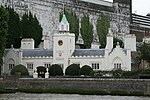Trafalgar Tavern
1830 establishments in England19th-century architecture in the United KingdomBuildings and structures in the Royal Borough of GreenwichCommercial buildings completed in 1830Grade II listed buildings in the Royal Borough of Greenwich ... and 3 more
Grade II listed pubs in LondonPubs in the Royal Borough of GreenwichUse British English from May 2014

The Trafalgar Tavern is a Grade II listed public house at Park Row, Greenwich, London, situated on the south bank of the River Thames, east of and adjacent to the Old Royal Naval College.
Excerpt from the Wikipedia article Trafalgar Tavern (License: CC BY-SA 3.0, Authors, Images).Trafalgar Tavern
Park Row, London East Greenwich (Royal Borough of Greenwich)
Geographical coordinates (GPS) Address Phone number Website External links Nearby Places Show on map
Geographical coordinates (GPS)
| Latitude | Longitude |
|---|---|
| N 51.4845 ° | E -0.0043 ° |
Address
The Trafalgar Tavern
Park Row
SE10 9NW London, East Greenwich (Royal Borough of Greenwich)
England, United Kingdom
Open on Google Maps








